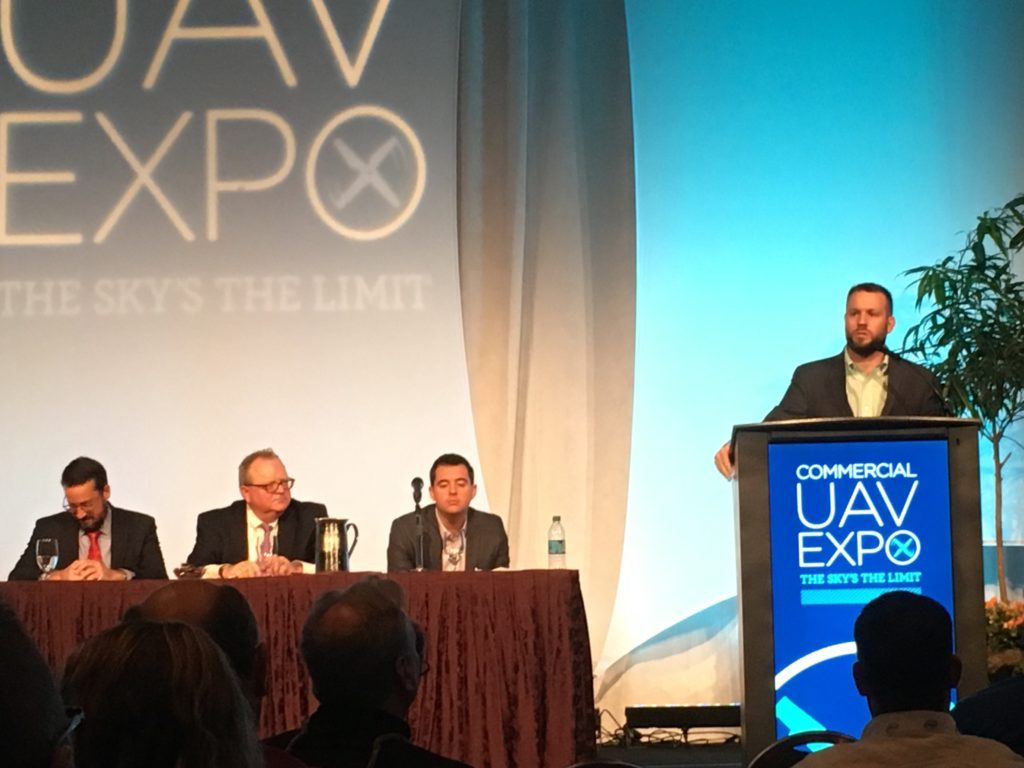 During a discussion panel at this week’s Commercial UAV Expo in Las Vegas, FAA attorney Dean Griffiths revealed Part 107 waiver statistics – and they don’t look good. As of last month, the FAA had received 912 requests for Part 107 waivers – and had issued 23. They had disapproved or withdrawn only 36.
During a discussion panel at this week’s Commercial UAV Expo in Las Vegas, FAA attorney Dean Griffiths revealed Part 107 waiver statistics – and they don’t look good. As of last month, the FAA had received 912 requests for Part 107 waivers – and had issued 23. They had disapproved or withdrawn only 36.
The fact that they have approved only about 2.5% of the requests – and processed only 6%, if you add in those disapproved – was no surprise to some drone operators in the audience, many of whom have lost jobs to people willing to work outside of the regulations while they wait for their waivers. When Griffiths was asked what the FAA plans to do to remedy the situation, he said that the agency was aware of the problem and had taken some actions to fix it, including releasing more information to ensure that applications are filled out correctly. “We recognize the need to do something,” said Griffiths.
The top three waiver requests were for night operations, often critical in thermography work; operations over people; and flight beyond visual line of sight (BVLOS.)
The numbers of requests for airspace authorization that have been granted were also stunningly low. Of 1,741 requests – over half of which were for access to Class C or D airspace – only 34 were approved.
Griffiths says that the FAA has several key initiatives in 2017. In addition to engagement with the drone advisory committee (DAC) and rulemaking initiatives, the FAA will work on the development of a single online portal for all types of users; streamlined systems of data sharing; the integration of drones into the air traffic control environment (UTM); and the legislative requirements outlined in the most recent FAA Reauthorization Act, including the development of reliable counter UAS measures. Griffiths says that the development of an online portal should improve the waiver process. “Something that will help is when we do get the unified portal together and automate those systems,” he said.
The FAA plans several rulemaking activities, including regularizing drone operations over people – which FAA chief administrator Michael Huerta has promised before the end of this calendar year -and other expanded operations. The agency also plans the formation of an unmanned aircraft system safety team, designed to provide data-based recommendations for safety to the drone industry.
Griffiths emphasized that the agency recognizes the need to move quickly while still maintaining safety, and is working towards integration of drones in the airspace – but acknowledged that it is a long process. “We’re committed to UAS integration,” said Griffiths. “…. We have a ways to go.”

Miriam McNabb is the Editor-in-Chief of DRONELIFE and CEO of JobForDrones, a professional drone services marketplace, and a fascinated observer of the emerging drone industry and the regulatory environment for drones. Miriam has penned over 3,000 articles focused on the commercial drone space and is an international speaker and recognized figure in the industry. Miriam has a degree from the University of Chicago and over 20 years of experience in high tech sales and marketing for new technologies.
For drone industry consulting or writing, Email Miriam.
TWITTER:@spaldingbarker
Subscribe to DroneLife here.







I understand their is a need for regulations on UAVs. My self i do not own a UAV or will i ever . I only say this because of the past 3 years fighting to get legal help to stop the unlawful use of UAVs and the criminal people operating them. I do not know of one person in my past that has used these UAVs for a good reason. i do know of how many horrible sick in humane acts that these destructive toys are capable of doing. I say this from experience. The US OF A government and the FAA need to stop and take two steps back and fix the first and the largest problem at hand that has been forgotten or ignored. I live in southern Kansas and in my state – the police , Sherif , State Police , FBI , OR our local FAA will not act on controlling the mis use of these bad TOYS. Not one of these local state or county departments will take actions to stop the criminal use of these UAVs. It makes me sick and depressed every time i may think about or look at these photos and videos i have collected and no legal justice for these horrible crimes . It is so sick what has happened to my family, friends , farm animals and my pets . My animals have taken the worst punishment only to try to hurt me and ruin my life . I hate being harassed and stalked and the main tool used by these sick people is a UAV. if you want to know more Google ..( ORGANIZED GANG STALKING ) There is some horrible sick people in this world and its happening rite here in america.
I did that. Googled “organized gang stalking”. I believe what Google says and one of the hits was “get organized gang stalking” at eBay.com. To put UAV’s as a major contributors to stalking, is like blaming telephones and cars and other harassment tools. Animals shouldn’t be used to make someone sorry. I feel really bad for Douglas Barnes. I googled him too. Nuf said. He probably believes that guns kill people too.
I wonder if the FAA’s UAV portal will be as successful as the Affordable Care Act’s portal for signing up new patient accounts? I see the need for safety regulations but small business suffers because of regulatory suffocation.